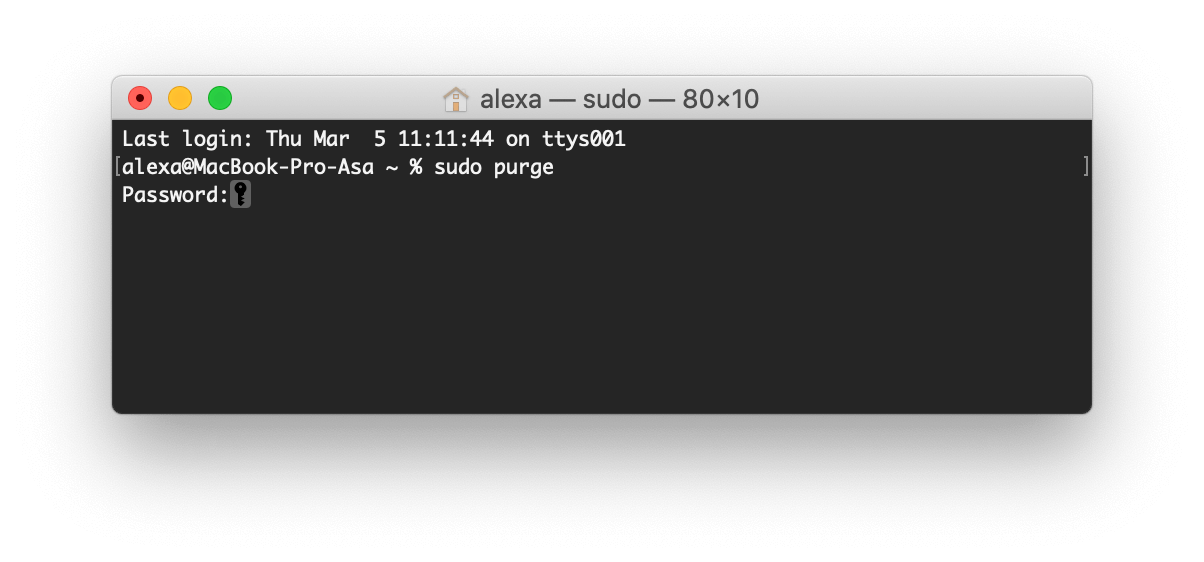- Clean up Parallels Desktop cache files: Parallels stores some cache files on your Mac, and you can click “Clean up” to delete the cache files associated with this particular virtual machine. If you need to compress the disk even further, try removing unnecessary files from it before using the “Reclaim” option in Parallels.
- Sep 10, 2021 Freeing up space on your Mac can be a tedious task, but it's an important one to ensure your computer continues to run smoothly and quickly. Doing so on a regular basis will help to reduce clutter.
- Freeing Up Memory On Macbook
- Freeing Up Memory On A Mac
- Freeing Up Ram On Mac
- How To Free Up Ram
- Free Up Memory On Mac App
Now is as good a time as any to tidy up your Mac, freeing up storage space and probably CPU cycles and RAM in the process. Here are a few tips to make quick work of your Mac “spring cleaning.”.
Freeing space on your Mac OS X startup disk
This extract from a chapter of our book Troubleshooting Mac® OS X describes several ways to free-up space on your Mac OS X startup disk, also known as your Mac OS X boot volume.
While you could replace your current hard drive with a larger model, or install a second internal hard drive if your Mac will support such, the following tips will help you to free some space without changing your hardware. Additional tips are provided for saving more space if you have a second internal hard drive or an available partition.
Determining available space on your startup disk
To check how much free space is available on your startup disk:
- In Finder®, select your startup disk's icon. For most users, this is Macintosh HD.
- Press the Command-I keyboard combination.
- The Get Info window for your startup disk will open. In the General pane, the Capacity, Available (free space), and space Used on your startup disk will be displayed, as seen in the following screen shot:
Simple ways to free space
You can employ any of the following tips to increase the free space available on your Mac OS X startup disk without altering your hardware.
Empty the Trash
As obvious as it may sound, some folks regularly Trash files but neglect to periodically empty the Trash. In Finder, select Finder > Empty Trash or, under Mac OS X 10.3 or later, you can also select Finder > Secure Empty Trash.
Do not use the Trash as a temporary storage area: only put an object in the Trash if you are sure it is no longer needed.
Some applications, such as iPhoto® and Mail, have their own Trash, spearate from the Trash seen in the Dock. Emptying the application’s Trash may delete its contents immediately or move its contents to your personal Trash, which you can then empty as noted above.
Archive old files
Archive — move, copy and delete, or backup and remove — files you do not use regularly to CD or another backup medium.
If you have not done so already, this is an excellent time to consider implementing a comprehensive backup and recovery solution.
Mac OS X 10.3 Panther® and later include a built-in function for creating compressed archives of files or folders. These archives are generally far smaller than the original files they contain, provided the original is not already in a compressed format. To use this function, see the following AppleCare® Knowledge Base document corresponding to the version of Mac OS X you are using:
Clean up system logs and temporary files
Follow the advice in our 'Running Mac OS X Maintenance Scripts' FAQ to regularly execute the Mac OS X maintenance routines that clean up System logs and temporary files created as part of the UNIX® underpinnings of Mac OS X.
Remove unused localization files
If you selected the Easy Install option when installing Mac OS X, localization files for over a dozen languages are installed. These files enable the Mac OS X interface to appear in a variety of languages. You can save roughly 200MB of disk space by removing unneeded localization files using the freeware utility Monolingual.
| Warning: | Be sure to thoroughly read the instructions before using Monolingual. Only use a version that is compatible with the version of Mac OS X you have installed. Never remove English localization files. Many applications require English and will not open if English is removed. |
Delete the Previous Systems folder from a prior Archive and Install
If you have performed an Archive and Install of Mac OS X, a Previous Systems folder was created containing your prior Mac OS X System folder. Once you are satisfied that your Mac is functioning properly after an Archive and Install, you can delete the Previous Systems folder as follows:
- Mac OS X 10.3 Panther® or later:
- Using your Admin account, drag the Previous Systems folder to the Trash.
- Type your Admin password when requested to authenticate this operation.
- Empty the Trash.
- Mac OS X 10.2 Jaguar: See the AppleCare Knowledge Base document 'Mac OS X 10.2: How to Delete a Previous Systems Folder.'
Uninstall unused applications
If your Macintosh HD > Applications folder is cluttered with applications you are no longer using or trial software that shipped with your Mac that you do not intend to use, then uninstall them.
Delete old iTunes Library file backups
Recent versions of iTunes® create a backup of your current iTunes Library file whenever the iTunes application is updated. After you are satisfied that an iTunes update is performing nominally, trash old iTunes Library files with your Home > Music > Previous iTunes Library folder, then empty the Trash.
Remove old iOS device backups
Apple iOS® devices (iPad®, iPhone®, iPod touch®) automatically back up specific files and settings to your Mac whenever they are connected to your computer. The backups are saved in your Home > Library > Application Support > MobileSync > Backup folder. While you should retain your most recent backups from these devices, older backups can be deleted in the Devices pane of iTunes preferences. For details, see the following AppleCare Knowledge Base documents:
Trashed iDVD or GarageBand? Don't forget the loops and themes…
If you plan to uninstall iDVD® or GarageBand® by moving these applications' icons from the Macintosh HD > Applications folder to the Trash, be sure to also trash the corresponding iDVD or GarageBand folders within the Macintosh HD > Library > Application Support folder. These folders contain iDVD themes and GarageBand loops and instruments, respectively, that consume several gigabytes of disk space.

Uninstall Mac OS 9
Freeing Up Memory On Macbook
If your PowerPC™-based Mac can only start up into Mac OS X and you have no need for Classic mode, you can uninstall Mac OS 9 to save additional space.
More ways to save space if you have a spare partition or second hard drive
If you have an available partition or a second hard drive, you can also save space on your Mac OS X startup disk with the following additional tips.

Freeing Up Memory On A Mac
Move your iTunes Music folder to another disk or partition
To change the location of your iTunes Music folder, carefully follow the instructions in the AppleCare® Knowledge Base document 'iTunes for Mac: Moving your iTunes Music folder.' Additional information can be found in iTunes Help.
Laptop users may want to consider having two iTunes libraries: a small library of current favorites on their computer, while their complete library resides on an external hard drive. Utilities like iTunes Library Manager enable you to easily have multiple iTunes libraries you can use with your account.
You can investigate other solutions for managing multiple iTunes libraries by searching MacUpdate and VersionTracker.
Move your iPhoto Library folder to another disk or partition

To move the iPhoto Library folder to a new location, employ the instructions in the AppleCare Knowledge Base document from this list corresponding to the version of iPhoto you are using. Additional information can be found in iPhoto Help.
Freeing Up Ram On Mac
Laptop users may want to consider having two iPhoto libraries: a small library of current, favorite photographs on their computer, while their complete library, or archives of older photos are saved on an external hard drive. Utilities such as iPhoto Buddy and iPhoto Library Manager enable you to have multiple iPhoto libraries that you can use with your account.
You can investigate other solutions for managing multiple iPhoto libraries by searching MacUpdate and VersionTracker.
How To Free Up Ram
What about moving my Home or Users folder?
The UNIX underpinnings of Mac OS X make it possible to move either your Home folder or the entire Users folder to a different disk or partition. While this seemed to work well for some users in the early days of Mac OS X, it has become problematic with respect to Mac OS X Updates.
Free Up Memory On Mac App
For example, we know of at least one Mac OS X Security Update that expected the Users folder on the Mac OS X startup disk. Those who had relocated Users to another partition had problems installing this update. Consequently, we do not recommend moving either your Home or Users folders to a different disk or partition.
Finding lost disk space
If you find your Mac OS X startup disk has become full unexpectedly:
- Check Console for clues. In particular, examine the various Console logs for large blocks of identical, repeating messages. Such blocks of repeating messages often indicate a runway process is logging excessively due to either a flaw in the process itself, its logging parameters, or a problem with your Mac. Excessive logging can result in log files growing without bounds.
- The utilities OmniDiskSweeper and WhatSize are great for finding large, invisible files. Be sure you understand the purpose of a large file before deleting it. In particular, Virtual Memory (VM) Swap files, located in the /private/var/vm directory, should not be deleted while your Mac is running. VM Swap files are created and released dynamically by Mac OS X.